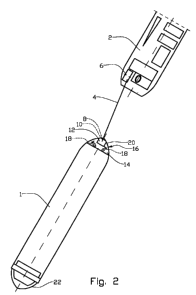Some of the information on this Web page has been provided by external sources. The Government of Canada is not responsible for the accuracy, reliability or currency of the information supplied by external sources. Users wishing to rely upon this information should consult directly with the source of the information. Content provided by external sources is not subject to official languages, privacy and accessibility requirements.
Any discrepancies in the text and image of the Claims and Abstract are due to differing posting times. Text of the Claims and Abstract are posted:
| (12) Patent: | (11) CA 2680755 |
|---|---|
| (54) English Title: | METHOD AND DEVICE FOR CONNECTING A TANKER AT SEA |
| (54) French Title: | PROCEDE ET DISPOSITIF DE COUPLAGE D'UN PETROLIER EN MER |
| Status: | Deemed expired |
| (51) International Patent Classification (IPC): |
|
|---|---|
| (72) Inventors : |
|
| (73) Owners : |
|
| (71) Applicants : |
|
| (74) Agent: | RIDOUT & MAYBEE LLP |
| (74) Associate agent: | |
| (45) Issued: | 2014-09-09 |
| (86) PCT Filing Date: | 2008-03-11 |
| (87) Open to Public Inspection: | 2008-10-23 |
| Examination requested: | 2013-02-06 |
| Availability of licence: | N/A |
| (25) Language of filing: | English |
| Patent Cooperation Treaty (PCT): | Yes |
|---|---|
| (86) PCT Filing Number: | PCT/NO2008/000088 |
| (87) International Publication Number: | WO2008/127117 |
| (85) National Entry: | 2009-09-14 |
| (30) Application Priority Data: | ||||||
|---|---|---|---|---|---|---|
|
A method and device for connecting a tanker (1) at a loading facility (2) at sea, in which, after having positioned itself at the loading facility (2), the tanker (1) is connected to a loading hose (4) for fluid to be transferred from the loading facility (2) to the tanker (1), and in which the stern (20) of the tanker (1) is turned towards the loading facility (2), the tanker (1) being provided, at its stern (20), with propulsion machinery (16) steerable in the horizontal plane, and in which the loading hose (4) is then connected to a cargo manifold (10) positioned at the stern (20) of the tanker (1).
L'invention concerne un procédé et un dispositif de couplage d'un pétrolier (1) à une installation de chargement (2) en mer dans lequel, après s'être positionné au niveau de l'installation de chargement (2), le pétrolier (1) est couplé à une conduite de chargement (4) pour transférer un fluide de l'installation de chargement (2) au pétrolier (1), et dans lequel la poupe (20) du pétrolier (1) est tournée vers l'installation de chargement (2), le pétrolier (1) étant pourvu, au niveau de sa poupe (20), d'une machinerie de propulsion (16) pouvant être dirigée dans un plan horizontal, et dans lequel la conduite de chargement (4) est ensuite couplée à un distributeur de chargement (10) positionnée au niveau de la poupe (20) du pétrolier (1).
Note: Claims are shown in the official language in which they were submitted.
Note: Descriptions are shown in the official language in which they were submitted.

For a clearer understanding of the status of the application/patent presented on this page, the site Disclaimer , as well as the definitions for Patent , Administrative Status , Maintenance Fee and Payment History should be consulted.
| Title | Date |
|---|---|
| Forecasted Issue Date | 2014-09-09 |
| (86) PCT Filing Date | 2008-03-11 |
| (87) PCT Publication Date | 2008-10-23 |
| (85) National Entry | 2009-09-14 |
| Examination Requested | 2013-02-06 |
| (45) Issued | 2014-09-09 |
| Deemed Expired | 2017-03-13 |
There is no abandonment history.
| Fee Type | Anniversary Year | Due Date | Amount Paid | Paid Date |
|---|---|---|---|---|
| Application Fee | $400.00 | 2009-09-14 | ||
| Maintenance Fee - Application - New Act | 2 | 2010-03-11 | $100.00 | 2009-09-14 |
| Maintenance Fee - Application - New Act | 3 | 2011-03-11 | $100.00 | 2011-01-27 |
| Maintenance Fee - Application - New Act | 4 | 2012-03-12 | $100.00 | 2012-02-14 |
| Maintenance Fee - Application - New Act | 5 | 2013-03-11 | $200.00 | 2013-01-15 |
| Request for Examination | $800.00 | 2013-02-06 | ||
| Maintenance Fee - Application - New Act | 6 | 2014-03-11 | $200.00 | 2014-01-22 |
| Final Fee | $300.00 | 2014-06-16 | ||
| Maintenance Fee - Patent - New Act | 7 | 2015-03-11 | $200.00 | 2015-02-16 |
Note: Records showing the ownership history in alphabetical order.
| Current Owners on Record |
|---|
| TEEKAY NORWAY AS |
| Past Owners on Record |
|---|
| HANSEN, HANS RICHARD |
| NORDTVEIT, REINERT |